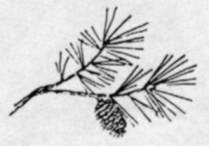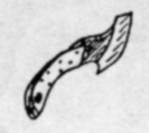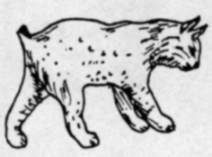 |
|
 |
|
|
Home →
Publications →
The Tracker Magazine →
Vol 1, No. 3, May 1982
|
The Tracker
Magazine - Vol 1 No. 3, May 1982
|
|
|
Tips From Tom
Tom Brown Jr.
|
|
|

|
Dehairing Deer Hides
One of the biggest problems faced when tanning
a hide is to quickly get the hair off without scraping yourself to death or
wrecking the hide. I have a number of excellent ways to remove the hair quickly,
without destroying the hide's texture or strength, which are listed below:
|
|
|
1. After thoroughly fleshing your hide, suspend
it in a fast running stream with the hair going against the flow. Depending on
the temperature of the water and its tannic acid content, the hair can be
literally wiped off in anywhere from one to three days. You should test your
hide frequently by pulling on the hair, and when it slips out easily with a
gentle tug, you're ready to rack it. Make sure that you don't leave it in too
long because this will cause damage to the skin.
2. Another way to get the hair loosened up fast
is to let the hide soak in worm water (not hot) for a day or two. It will help
to add some tannic acid to the water also. You can get some tannic acid from
boiling acorns, cedar bark, or oak bark in a pot of water until the water turns
a deep reddish brown. Some old Lenne Lenape people here in New Jersey not only
add the tannic acid, but also add some wood ash (a handful or two) to aid in the
hair removal.
3. Another good way of loosening up the hair on
a hide is to soak it for 24 hours in ocean water. That is, of course, if you
live near the ocean. I find that saltwater does not work as well and could
damage the hide (by salt water, I mean NaCl and H2O, not ocean water).
4. If you have a hide. that is badly fat
stained (the kind you get from a friend that hasn't been fleshed properly and
has lain around for a few weeks), you can get rid of most of the fat stains by
washing it in Ivory Snow. For those purists, use the root of yucca, phlox, or
bouncing bet as your natural soap. Remember there are over 200 species of plants
that make a great soap.
|
|
 |
Cedar Bark Cordage
During an Advanced Standard campout, I noticed
that many of my students were having trouble making cedar bark cordage, cedar
bark clothing, and cedar bark baskets. They found that the cedar they were
working with was too brittle, and would fall aport and dust up too easily. My
suggestion, whenever working cedar, is to take the cedar bark from a standing
dead tree, and allow it to soak from 2-4 hours. This is most convenient since
most cedars grow in damp areas. After soaking the bark, there are two types of
cedar cordage that you can make. The outer fibers can be made into serviceable
cordage and baskets. The inner fibers are softer, also making good cordage, but
finer clothing.
|
|
|
Using the basket weave, or reverse wrap method,
you con easily make yourself a vest, a hat, a pair of sandals, etc. out of the
inner bark of these cedars that have been soaked. In a short period of time the
cedar fibers will dry and bind together more evenly but still maintain their
swell for many years.
The dried innermost bark of cedar also makes
the best type of tinder bundles.
|
|
|
Pitch Sticks
You can get pitch sticks from almost any
evergreen tree, especially pitch pine, Douglas fir, and balsam fir. A pitch
stick will burn even when damp and has the ability to burn even in a good wind.
By adding them to your fire before you start it, you will insure that your fire
will start even in adverse conditions.
To find a source of pitch sticks simply kick
open an old rotted evergreen stump to reveal its thick, hard core. This core is
where all the pitch has settled after the tree was killed, and will smell
strongly resinous. It is a great idea to carry a few pitch sticks with you for
emergency use.
|
 |
|
|
|
Super Tinder Bundle
You can make your tinder bundle into on
explosive mass if you add some spores of the puff ball to it. For a long time
the spores of the puff ball were used as a flash powder for picture taking
before flash bulbs were invented. Be careful though, you may get burned.
|
|
|
Scent Glands and Urine
Students hear me say that there are many things
an animal can be used for and all parts should be used. But the one thing that
students can't figure out is what to do with the urine, scat, and scent glands
of animals. By taking these parts and using them as a lure for other animals,
you will have great trapping results.
On the farm we had problems with a rogue fox
that would refuse to be trapped. I took the urine and scat of another fox I got
from a friend and made a scent pile near my trap. The bandit fox was so angry
that another fox had taken over part of his territory that he stayed around the
area of the pile and was eventually caught by my trap. The fox is now doing
fine, living in a new area far away from the farm.
|
|
|
De-scenting Tip
If you don't have the time to go through all
the de-scenting techniques described in the class, there is a quick method that
you can carry with you when you're afield.
Simply take a common, fragrant, nonpoisonous
plant found in the area you are going to be stalking in and brew a strong tea
from it. Place the tea in a small atomizing bottle and carry it with you during
your outing. When you need to de-scent, simply spray your body with the tea to
help mask your scent. Be careful, though, because bees and insects are attracted
to the smells also. Good plants to use are sage, sweetgrass, mint, catnip, pine,
cedar, and mullein flowers.
|
|
 |
Attracting Bobcat
Bobcat are one of the most difficult animals to
approach and study because of their keen senses. I find that by simply dangling
a feather from a tree branch near my blind, I can draw in the curious cats to my
area. In fact, the dangling feather works on most predators and you will have
fine results when used with a predator call or a twittering call made by sucking
your teeth.
|
|
|
|
|
Previous
Contents Next
|
|
This website has no
official or informal connection to the Tracker School or Tom Brown Jr.
whatsoever |
|
|
 |
|
•
•
•
•
•
•
|
 |
|
|

